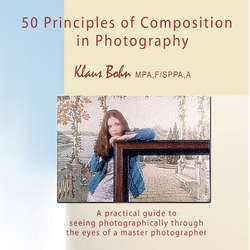Читать книгу 50 Principles of Composition in Photography: A Practical Guide to Seeing Photographically Through the Eyes of A Master Photographer - Klaus Bohn - Страница 5
На сайте Литреса книга снята с продажи.
ОглавлениеTable of Contents
Dedication
Foreward
Introduction
Photography: Unlike the Other “Fine” Arts
Talent
Why Are You a Photographer?
Education
Objective Versus Subjective Learning
It Is Not About the Camera
Can You be a Photographer?
The Importance of Composition
50 Principles of Composition
1. Moving in Close
2. Placing Center of Interest
3. Placing Secondary Objects
4. “Framing” the Photograph
5. Dividing the Photograph
6. Separating the Subject and Background
7. Avoiding Mental Hazards
8. Balancing for Harmony
9. Choosing Vertical or Horizontal Formats
10. Leading Lines
11. Moving Objects
12. Placing People
13. Centralization of Religious Symbols
14. Colour Composition
15. Filters
16. Avoiding Center of Interest
17. Suggesting What is Not Apparent
18. Fore-, Middle, and Background
19. Rhythm
20. Texture
21. Omitted Items
22. Space
23. Value Contrast
24. Circles
25. Pyramids
Composition in Hindsight
26. Radii
27. Rectangles
28. Planes
29. Colour Mergers
30. Perspective
31. Exploration
32. Isolation
33. Organization
34. Perception
35. Storytelling
36. Pictures Have Edges
37. Monocular Vision
38. Discriminating Objects
39. Movement
40. Sequence
41. Tonal Interchange
42. Reviewing Through Diagrams
43. Light and Texture
44. Time
45. Symbol
46. Organizing the Picture
47. Abstraction and Ambiguity of Space
48. Surrealism
49. Light
50. Imagination
Creativity in Photography
Photography
The Driven Man
Closing Remarks: A Summary
About the Author
Photographic Watercolour & Bromoil Print Examples
How to Contact Klaus Bohn
